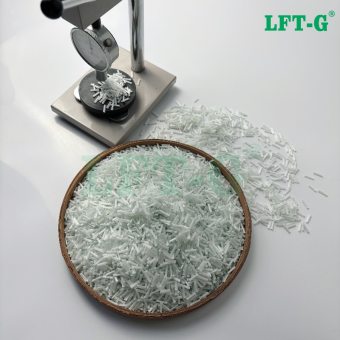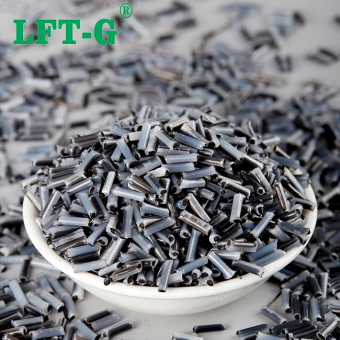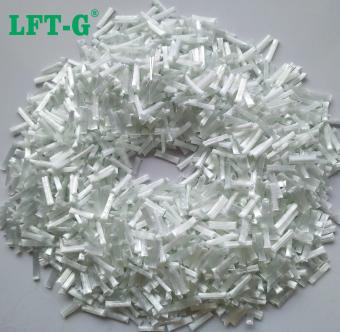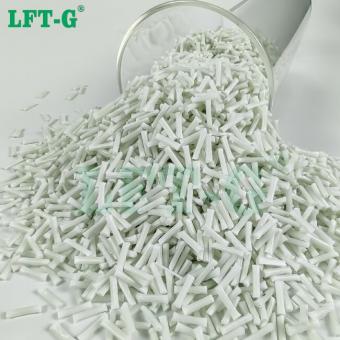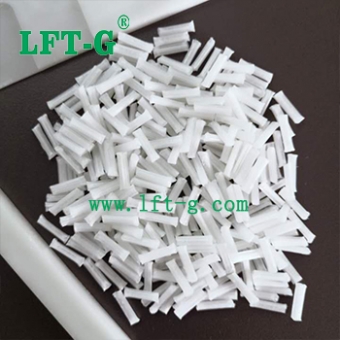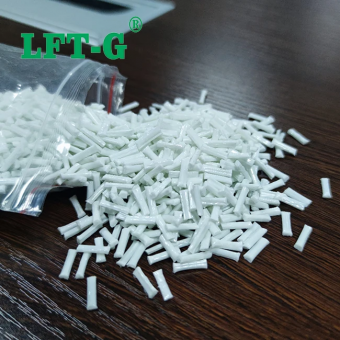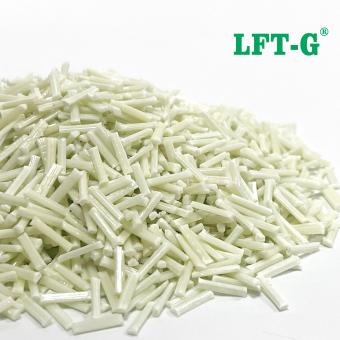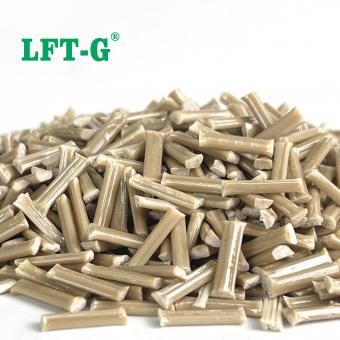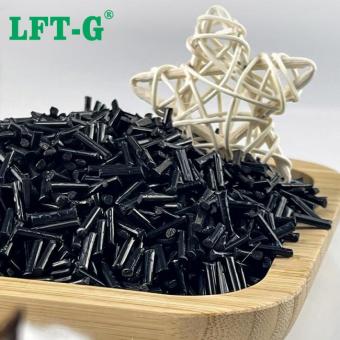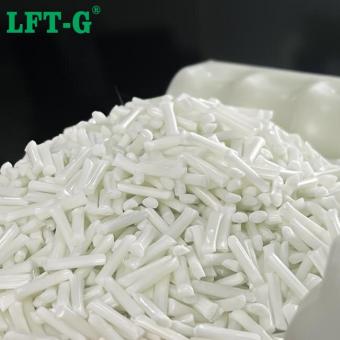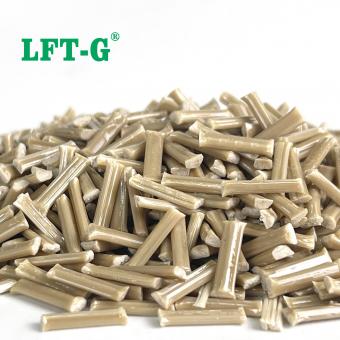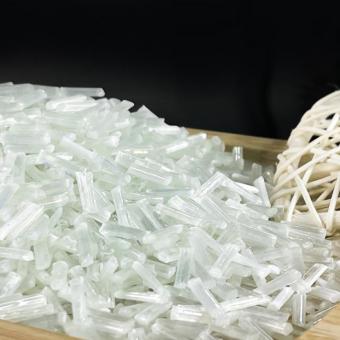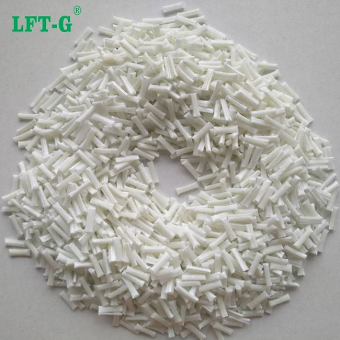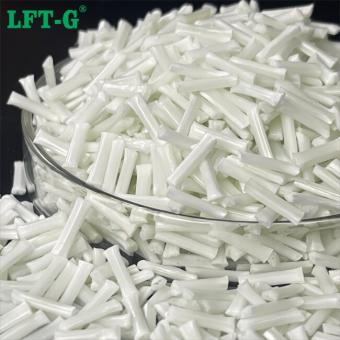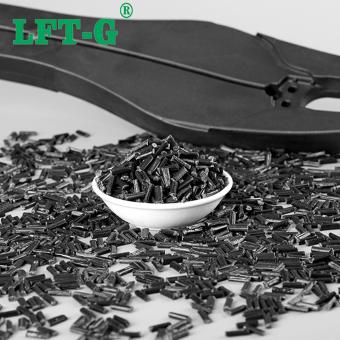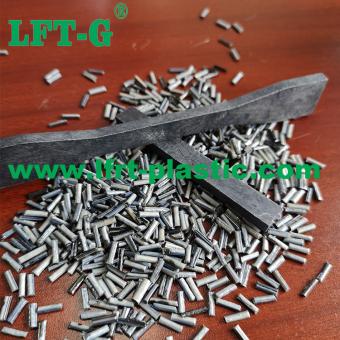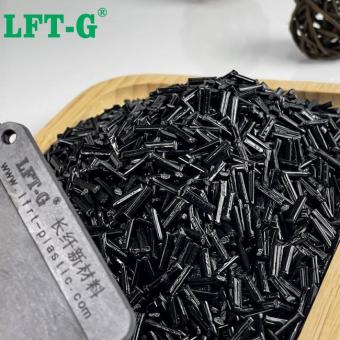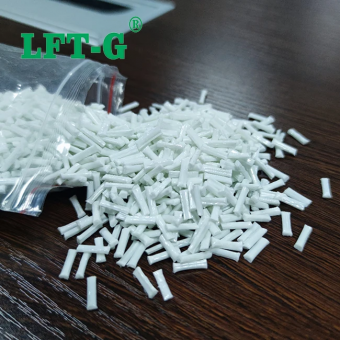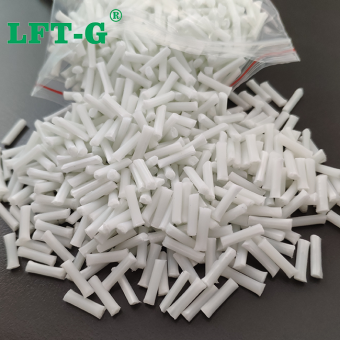-
Xiamen LFT Nylon series Polyamide 66 Long Glass Fiber Reinforced Thermoplastic ResinPolyamide, which is also known by the trade name, Nylon, has excellent heat resistant properties, especially when combined with additives and filler materials. In addition to this, Nylon is very resistant to abrasion. Xiamen LFT offers a wide range of temperature-resistant nylons with many different filler materials. About PA66-LGF compounds Nylon 6,6, also written as nylon 6-6, nylon 66, or nylon 6/6, is a more crystalline version of nylon 6. It is also referred to as polyamide 66 or PA 66. It has improved mechanical properties due to its more ordered molecular structure. Nylon 66 for machining has improved temperature resistance and lower rates of water absorption when compared to standard nylon 6. The advantages of nylon 6,6 are that the yield strength is higher than nylon 6 and nylon 610. It has high strength, toughness, rigidity, and low coefficient of friction in a wide temperature range. In addition, it is oil resistant and resistant to chemical reagents and solvents. However, PA66 has strong hygroscopicity and poor dimensional stability, which limits its application. In order to obtain nylon 66 engineering material with higher strength, it should be modified by glass fiber reinforcement. The mechanical properties of long glass fiber reinforced nylon 66 (LGFR-PA66) are obviously better than those of short glass fiber reinforced nylon 66 (SGFR-PA66), and the molding processing performance is also better. It can be molded by various molding methods such as injection molding and compression molding, and complex components can also be formed. Therefore, long glass fiber reinforced nylon 66 can be widely used in building materials, aerospace, electronic devices, furniture and other fields, especially in the automotive industry application market. The production process of long glass fiber reinforced nylon 66 is different from that of short glass fiber reinforced nylon 66. The short glass fiber reinforced nylon 66 particle is chopped under the friction and shearing of screw and barrel, and the short glass fiber reinforced nylon 66 particle is obtained with the length of glass fiber monofilament about 0.5mm. The length of some glass fiber monofilament in the final product is lower than the critical length of reinforcement, and the glass fiber is easy to be extracted from the nylon 66 matrix when the product is stressed. The strength of glass fiber is not fully utilized, and the mechanical properties of the product are not high. Long glass fiber reinforced nylon 66 has better reinforcement effect and dimensional stability, and the rigidity, tensile, bending, impact resistance and fatigue resistance of the manufactured products are better, and the service life is longer. Materials Details Number PA66-NA-LGF Color Natural color or Customized Length 6-25 mm Package 25kg/bag MOQ 25kg Lead time 2-15 days Port of Loading Xiamen Port Trade terms EXW/FOB/CFR/CIF/DDU/DDP About Xiamen LFT Xiamen LFT Composite Plastic Co.,LTD was established in 2009, is a brand-name global suppliers of long fiber reinforced thermoplastic materials integrating product research & developmen (R&D), production and sale marketing. Our LFT products have passed the ISO9001&16949 system certification and have obtained lots of national trademarks and patents, covering the fields of automotive, military parts and firearms, aerospace, new energy, medical equipment, power wind energy, sports equipment, etc. LFT long fiber reinforced thermoplastic engineering materials,compared to ordinary short fiber reinforced thermoplastic materials (fiber length is less than 1-2 mm), the LFT process produces thermoplastic engineering material's fibers in lengths of 5-25 mm. The long fibers are impregnated with the resin through a special mold system to obtain long strips that are fully impregnated with the resin ,and then cut to the length as required. The most used base resin is PP, by PA6, PA66, PPA,PA12,MXD6,PBT,TPU,PPS, ABS,PEEK, etc. Conventional fibers include glass fiber, carbon fiber. Depending on the end use, the finished products can be used for injection molding,extrusion, molding, etc., or directly used for plastic instead of steel and thermoset products.
- PA66 PA 6.6 Enginering materials
- excellent heat resistance with filler
- injection molding products light weight
- car parts toy home applance use
- modified plastic manufacturer can be customized
- can be recylced GFRP GF30
Tags :
-
Xiamen LFT high performance Polyphenylene Sulfide Long Glass Fiber Reinforced Thermoplastic PolymersPPS is a high-performance, tough engineering plastic with great dimensional and thermal stability, as well as a wide operating temperature range of up to 260 °C and good chemical resistance. Moreover, PPS, like most other thermoplastics, is an electrical insulator. Its ability to be used at high temperatures coupled with its thermal stability makes PPS great for applications such as semiconductor components in machinery, bearings, and valve seats. About PPS-LGF compounds PPS plastic (polyphenylene sulfide), English name: Polyphenylenesulfide, is a thermoplastic special engineering plastic with excellent comprehensive properties. Its outstanding features are high temperature resistance, corrosion resistance and superior mechanical properties. The product will make a metallic sound when it is dropped to the ground. . Pure PPS is rarely used alone due to its brittle performance. Most of the PPS used is its modified variety. Glass fiber reinforced PPS is one of them. PPS lengthened glass fiber (LGF) composite material has the advantages of high toughness, low warpage, fatigue resistance, and good product appearance. It can be used in water heater impellers, pump casings, joints, valves, chemical pump impellers and casings, cooling water impellers and Shells, home appliance parts, etc. Automotive industry Applications: Due to its excellent mechanical properties, thermoplastic carbon fiber is widely used in the automotive field of fuel system components, sensors, shell components. On the one hand, it is because of the high strength and stiffness of PPS-LCF, and the finished parts are not easy to damage. On the other hand, PPS-LCF also has a relatively low coefficient of thermal expansion to ensure the stability of the finished product. In addition, PPS-LCF also has very good corrosion and heat resistance, making the application life of the finished product longer. Industrial Applications: In the industrial field, it is mainly used in the parts of equipment, such as chemical processing equipment, air pumps, gaskets, valves, etc. In addition to the high strength of the PS-LCF, it is also because the parts made by the PS-LCF have very good self-lubricating properties, which is very important for mechanical parts. Therefore, compared with the traditional carbon fiber material products, the performance has been greatly improved. The wide range of applications of PPS-LCF include aerospace, automotive manufacturing, electronic equipment, chemical and medical fields. Basic Performance of PPS-LGF 1 Excellent overall performance. PPS resin is a crystalline polymer with high hardness. Its crystal content is about 65% and its density is 1.34g/cm^3. It has excellent mechanical properties. Its tensile strength and bending strength are better than those of PA, PC, PBT, etc. It has extremely high rigidity and creep resistance. The mechanical properties will better after adding glass fiber reinforcement. 2 Excellent heat resistance. Its melting point can reach 275~291℃, and its heat distortion temperature is 135℃. After glass fiber reinforcement, its heat distortion temperature can reach 260℃. In air, polyphenylene sulfide reaches the weakening temperature at about 400°C, and polyphenylene sulfide begins to decompose in air at 700°C. The long-term use temperature is 200~240℃, and the thermal stability of long-term continuous use is better than all current engineering plastics. 3 The dielectric strength is better. PPS has a symmetrical molecular structure, non-polarity, and low water absorption, so its electrical insulation is very good. Compared with other engineering plastics, its dielectric constant is small, and its arc resistance is equivalent to that of thermosetting plastics. It can be used in high temperature, high humidity, frequency conversion, etc. Under harsh conditions, PPS can still maintain excellent electrical insulation. 4 preservative. Because PPS has a high degree of crystallinity, it has excellent chemical resistance and is insoluble in any organic solvent below 200°C. In addition to strong oxidizing acids, it can withstand the erosion of various acids, alkalis, and salts. After being soaked in various chemicals for a long time, it still maintains high strength. Materials Details Number PPS-NA-LGF Color Natural color or Customized Length 6-25 mm Package 25kg/bag MOQ 25kg Lead time 2-15 days Port of Loading Xiamen Port Trade terms EXW/FOB/CFR/CIF/DDU/DDP About Xiamen LFT Xiamen LFT Composite Plastic Co.,LTD was established in 2009, is a brand-name global suppliers of long fiber reinforced thermoplastic materials integrating product research & developmen (R&D), production and sale marketing. Our LFT products have passed the ISO9001&16949 system certification and have obtained lots of national trademarks and patents, covering the fields of automotive, military parts and firearms, aerospace, new energy, medical equipment, power wind energy, sports equipment, etc. LFT long fiber reinforced th...
- High performance thermoplastic engineering plastics
- High temperature and corrosion resistance
Tags :
-
Xiamen LFT Thermoplastic Polyurethane (TPU) Long Glass Fiber Reinforced Thermoplastic CompoundsThermoplastic Polyurethane is soft and elastic, with excellent tensile and tear strength. For this reason, it is often used to make parts that demand a rubber-like elasticity. TPU is a little bit expensive than other resins, but there is no substitute for many applications, such as protective wire and cable sheaths. Another advantage is that TPU improves the grip for products that need to be held securely in hand. About TPU-LGF compounds What Products Are Best Manufactured via Thermoplastic Polyurethane (TPU)? Some of the TPU products manufactured are automotive instrument panels, caster wheels, sporting goods, power tools, drive belts, medical devices, footwear and etc. What is Thermoplastic Polyurethane (TPU) for Plastic Injection Molding? ETPU is a tough, highly abrasion-resistant resin that bridges the gap between rubbers and plastics. TPUs can be formulated to be rigid or elastomeric. TPU exhibits a high flex before break and is ideal for wheels and door panels. What is the Molding Temperature for Thermoplastic Polyurethane (TPU)? depending on the TPU being molded. Materials Details Number TPU-NA-LGF Color Natural color or Customized Length 6-25 mm Package 25kg/bag MOQ 25kg Lead time 2-15 days Port of Loading Xiamen Port Trade terms EXW/FOB/CFR/CIF/DDU/DDP About Xiamen LFT Xiamen LFT Composite Plastic Co.,LTD was established in 2009, is a brand-name global suppliers of long fiber reinforced thermoplastic materials integrating product research & developmen (R&D), production and sale marketing. Our LFT products have passed the ISO9001&16949 system certification and have obtained lots of national trademarks and patents, covering the fields of automotive, military parts and firearms, aerospace, new energy, medical equipment, power wind energy, sports equipment, etc. LFT long fiber reinforced thermoplastic engineering materials,compared to ordinary short fiber reinforced thermoplastic materials (fiber length is less than 1-2 mm), the LFT process produces thermoplastic engineering material's fibers in lengths of 5-25 mm. The long fibers are impregnated with the resin through a special mold system to obtain long strips that are fully impregnated with the resin ,and then cut to the length as required. The most used base resin is PP, by PA6, PA66, PPA,PA12,MXD6,PBT,TPU,PPS, ABS,PEEK, etc. Conventional fibers include glass fiber, carbon fiber. Depending on the end use, the finished products can be used for injection molding,extrusion, molding, etc., or directly used for plastic instead of steel and thermoset products.view more
-
Xiamen LFT ABS (Acrylonitrile Butadiene Styrene) Long Glass Fiber Reinforced Thermoplastic CompoundsABS is another preferred type of engineering plastic that is valued for its chemical and thermal stability, strength, toughness, and glossy finish. Its host of desirable properties make it a versatile material. It is used in everything from consumer products like toys and bicycle helmets to automotive applications such as interior trim pieces, housings for electronics, and more. After adding glass fiber to ABS, the rigidity, heat resistance and dimensional stability of the composite are significantly improved. In addition, the cost performance of ABS plus glass fiber is extremely good, which can meet the needs of manufacturers while reducing costs. About ABS-LGF compounds The main application scope of modified ABS: 1. Auto parts: instrument panels, fenders, car interiors, car lights, reversing mirrors, car audio; 2. Electronic and electrical components: IT equipment, OA equipment shells, converters, etc., power sockets, etc.; 3. Electronic appliances: switches, power switches, controllers, monitors, monitor housings, electrical housings, electrical brackets; 4. Home appliances: electrical components, electrical control boxes What Are the Advantages of ABS Injection Molding? The advantages of ABS injection molding are: 1. High Productivity - Efficiency Injection molding is a highly efficient and productive manufacturing technology and is the preferred method of manufacturing ABS parts. The process creates limited waste and can produce large volumes of parts with limited human interaction. 2. Design of Complex Parts Injection molding can produce multi-featured, complex components that can include metal inserts or overmolded soft-grip handholds. 3. Increased Strength ABS is a strong, lightweight thermoplastic that is widely used in a number of industries due to these properties. As such, injection molding in ABS is ideal for applications that require increased durability and overall mechanical strength. 4. Flexibility of Color and Material ABS is easily colored with a wide range of colors. It must be noted however that ABS has poor weathering resistance and can be degraded by UV light and prolonged outdoor exposure. Fortunately, ABS can be painted and even electroplated with metal to improve its environmental resistance. 5. Decreased Waste Injection molding is inherently low-wastage production technology due to the large production volumes that injection molding was designed for. When millions of parts are made per year, any amount of wastage adds up to a significant cost over time. The only wastage is the material in the sprue, runners, and the flashing between mold halves. 6. Low Cost of Labor Due to the highly automated nature of injection molding, very limited human intervention is required. Reduced human intervention results in reduced labor costs. This reduced labor cost ultimately results in a low cost per part. Materials Details Number ABS-NA-LGF Color Natural color or Customized Length 6-25 mm Package 25kg/bag MOQ 25kg Lead time 2-15 days Port of Loading Xiamen Port Trade terms EXW/FOB/CFR/CIF/DDU/DDP About Xiamen LFT Xiamen LFT Composite Plastic Co.,LTD was established in 2009, is a brand-name global suppliers of long fiber reinforced thermoplastic materials integrating product research & developmen (R&D), production and sale marketing. Our LFT products have passed the ISO9001&16949 system certification and have obtained lots of national trademarks and patents, covering the fields of automotive, military parts and firearms, aerospace, new energy, medical equipment, power wind energy, sports equipment, etc. LFT long fiber reinforced thermoplastic engineering materials,compared to ordinary short fiber reinforced thermoplastic materials (fiber length is less than 1-2 mm), the LFT process produces thermoplastic engineering material's fibers in lengths of 5-25 mm. The long fibers are impregnated with the resin through a special mold system to obtain long strips that are fully impregnated with the resin ,and then cut to the length as required. The most used base resin is PP, by PA6, PA66, PPA,PA12,MXD6,PBT,TPU,PPS, ABS,PEEK, etc. Conventional fibers include glass fiber, carbon fiber. Depending on the end use, the finished products can be used for injection molding,extrusion, molding, etc., or directly used for plastic instead of steel and thermoset products.view more
-
Xiamen LFT Nylon Polyamide 6 Long Glass Fiber Reinforced Thermoplastic CompoundsWhy Use Polyamide? The reason behind choosing polyamide over other materials will vary for different applications. When using polyamide for electrical cable protection, it offers better performance, flexibility, and impact resistance than PVC protection. In the automotive industry, it is used because it is cheaper and lighter than metal. In machines, it is used over other materials due to its high flexibility and durability. About PA6-LGF compounds The main application scope of modified PA6: 1. Auto parts: instrument panels, fenders, car interiors, car lights, reversing mirrors, car audio; 2. Electronic and electrical components: IT equipment, OA equipment shells, converters, etc., power sockets, etc.; 3. Electronic appliances: switches, power switches, controllers, monitors, monitor housings, electrical housings, electrical brackets; 4. Home appliances: electrical components, electrical control boxes What Are the Advantages of Nylon 6? The main advantages of nylon 6 are its stiffness and resistance to abrasion. Moreover, this material has excellent impact strength, wear resistance, and electrical insulating properties. Nylon 6 is a highly elastic and fatigue-resistant material, meaning it will return to its original proportions after being distorted by tension. This polyamide is non-toxic and can be combined with glass or carbon fibers to increase performance. The absorption capacity of the material grows in direct proportion to the quantity of moisture it absorbs. The high affinity of nylon 6 for some dyestuffs allows for more dyeing diversity, with the potential for brighter, deeper patterns. Materials Details Number PA6-NA-LGF Color Natural color or Customized Length 6-25 mm Package 25kg/bag MOQ 25kg Lead time 2-15 days Port of Loading Xiamen Port Trade terms EXW/FOB/CFR/CIF/DDU/DDP About Xiamen LFT Xiamen LFT Composite Plastic Co.,LTD was established in 2009, is a brand-name global suppliers of long fiber reinforced thermoplastic materials integrating product research & developmen (R&D), production and sale marketing. Our LFT products have passed the ISO9001&16949 system certification and have obtained lots of national trademarks and patents, covering the fields of automotive, military parts and firearms, aerospace, new energy, medical equipment, power wind energy, sports equipment, etc. LFT long fiber reinforced thermoplastic engineering materials,compared to ordinary short fiber reinforced thermoplastic materials (fiber length is less than 1-2 mm), the LFT process produces thermoplastic engineering material's fibers in lengths of 5-25 mm. The long fibers are impregnated with the resin through a special mold system to obtain long strips that are fully impregnated with the resin ,and then cut to the length as required. The most used base resin is PP, by PA6, PA66, PPA,PA12,MXD6,PBT,TPU,PPS, ABS,PEEK, etc. Conventional fibers include glass fiber, carbon fiber. Depending on the end use, the finished products can be used for injection molding,extrusion, molding, etc., or directly used for plastic instead of steel and thermoset products.view more
-
Xiamen LFT-G PEEK high quality modified thermoplastic fill long carbon fiber for automotivesWhat is PEEK? Polyether ether ketone (PEEK) is a semi-crystalline thermoplastic polymer material with rigid benzene ring, compliant ether bond and carbonyl group which can promote the intermolecular force in its molecular chain. PEEK has excellent wear resistance, electrical insulation, anti-radioactivity, chemical stability, biocompatibility and thermal stability. In addition, PEEK is reusable and has a high recovery rate. PEEK is widely used in aerospace, electronic and electrical appliances, biomedicine, Marine protection, automobile industry and other fields. PEEK material is an inert material with low surface free energy, and its mechanical properties and frictional properties cannot meet the needs of some special fields. Therefore, it is necessary to modify PEEK composite material to improve its comprehensive properties. At present, filling modification and blending modification are the main methods for preparing PEEK composite materials. Filler modified reinforcement materials mainly include fiber, inorganic particles and whisker; The polymer used for blending modification should have similar polarity and solubility to PEEK. The interface modification method can improve the interface adhesion and enhance the comprehensive properties of PEEK composites. What is PEEK filling Long Carbon Fiber? As a filling system, fiber can effectively carry part of the load, and the synergistic action between fiber and PEEK can improve the comprehensive performance of composite materials. Carbon fiber and glass fiber are widely used as filler modified composites because of their high strength, high modulus and high durability. Long carbon fiber (LCF) can be used as heterogeneous nucleating agent to promote the crystallization of PEEK in composite materials, which can effectively improve the mechanical and tribological properties of composite materials. PEEK/CF composites of different lengths were prepared by injection molding, and their infiltrating and tribological properties were studied. The results show that the addition of CF increases the contact Angle and decreases the hydrophilicity of the composites. But the friction coefficient of composites is reduced and the friction resistance is improved. Long carbon fiber (LCF) has better effect on reducing friction coefficient than short carbon fiber (SCF). TDS of PEEK for reference Application of PEEK CF Q&A 1. What are the advantages of long carbon fiber materials? A: Thermoplastic LFT Long carbon fiber material has high rigidity, good impact strength, low warpage, low shrinkage, electrical conductivity and electrostatic propertiea, and its mechanical properties are better than glass fiber series. Long carbon fiber has the characteristics of lighter and more convenient processing to replace metal products. 2. Are there any special process requirements of long carbon fiber injection molding products? A: We must consider the requirements of long carbon fiber for the injection molding machine screw nozzle, mold structure and injection molding process. Long carbon fiber is a relatively high cost material, and need to evaluate the cost performance problem in the selection process. 3. The cost of long fiber products is higher. Does it has a high recycling value? A: The thermoplastic LFT long fiber material can be recycled and reused very well. We will offer you: 1. LFT & LFRT material technical parameters and leading edge design 2. Mold front design and recommendations 3. Provide technical support such as injection molding and extrusion molding
- PEEK resin lcf low cost savings
- Polyether ether ketone filled lcf
- instead medal plastic peek long life
- injection molding platic peek catbon fiber
- long carbon fiber series peek filament
- higher toughness peek lcf for car aerospace
Tags :
-
LFT-G high quality Nylon PA12 filled LGF self-own factory for automotive partsPA12 materials PA12 is nylon 12, also known as poly dodecalactam, poly laurolactam, is a long carbon chain nylon. Nylon 12 in the existence of non-polar methylene groups, and a large number, which makes the nylon 12 molecular chain of the greater flexibility; nylon 12 amide groups in the polarity, and cohesion energy is very large, and its molecules can be formed between the hydrogen bonding, so that the molecular arrangement of the more regular. Therefore, the crystallinity of nylon 12 is high, and the strength is also high. Nylon 12 (PA12) low water absorption, good low temperature resistance, good airtightness, alkali resistance, grease resistance is excellent, resistance to alcohols and inorganic dilute acids and aromatics performance is medium, mechanical properties and electrical properties are also good, and is a self-extinguishing material. PA12 filling Long carbon fiber compounds
- Polyamide 12 Nylon series PA
- Injection molding products made in China Supplier
- long carbon fiber reinforcement Nylon resins
Tags :
-
LFT-G PBT Long Glass Fiber Reinforced Thermoplastic Resin Compounds Pellets EngineeringWhat is PBT? Polydibutyl terephthalate is a crystalline thermoplastic engineering plastic polymerized by dimethyl terephthalate (DMT) and 1,4-butanediol. PBT can also be called thermoplastic polyester plastic, in order to be used by different processing operators, generally how many additives will be added, or mixed with other plastics, with the proportion of additives is different, can manufacture different specifications of products. Due to its special properties, PBT is an ideal material for special applications in electrical engineering and electronics. 1. mechanical properties: high strength, fatigue resistance, dimensional stability, creep is also small (there is little change under high temperature conditions) 2. heat resistance aging: enhanced UL temperature index of 120~140℃(outdoor long-term aging is also very good) 3. solvent resistance: no stress cracking 4. water stability: PBT is not easy to decompose in water 5. insulation performance: excellent (wet, high temperature can also maintain stable electrical performance) What is fiberglass? Glass fiber (formerly known as glassfiber) is an inorganic nonmetallic material with excellent properties. It is made of pyrophylla, quartz sand, limestone, dolomite, borocalcium, boromite and seven ores as raw materials by high-temperature melting, wire drawing, winding, weaving and other processes. The diameter of its monofilament ranges from several microns to more than twenty microns, equivalent to 1/20-1/5 of a hair, and each fiber filament is composed of hundreds or even thousands of monofilament. Fiberglass products are relatively environmentally friendly within the controllable range. PBT has very weak hygroscopic properties. The tensile strength of the non-enhanced PBT is 50MPa, and the tensile strength of the glass fiber reinforced PBT is 170MPa. PBT crystallizes very quickly, so it is easy to bend and deform parts during injection molding due to uneven cooling. The shrinkage rate of general PBT materials is between 1.5% and 2.8%. PBT materials with 30% glass fiber reinforcement shrink between 0.3% and 1.6%. 1. high temperature resistance After testing, when the temperature reaches 300℃, there is no effect on the strength of glass fiber. 2. high tensile strength The tensile strength of glass fiber is 6.3~6.9g/d in the standard state, and 5.4~5.8g/d in the wet state. 3. good electrical insulation Glass fiber has excellent electrical insulation, is a high-level electrical insulation material, and is also used in insulation materials and fire shielding materials. 4. Burn Glass fiber can be melted into glass beads at high temperature, which meets the requirements of fire prevention and control in the construction industry. 5. good sound insulation The combination of glass fiber and gypsum can achieve a good sound insulation effect Why filled PBT with glass fiber? Adding glass fiber to PBT is a common method of PBT enhancement modification. Glass fiber and PBT resin bonding force is good, after adding a certain amount of glass fiber to PBT resin, not only can maintain the original advantages of PBT resin chemical resistance, processability and so on, but also can greatly improve its mechanical properties, and overcome PBT resin notch sensitivity. Impacts of Long Glass Fiber Reinforced PBT Compounds 01Wear resistance PBT has excellent wear resistance and is advantageous where resistance to friction and wear is required. In applications such as mechanical transmission components and bearings, the wear resistance of PBT has been effectively utilized. 02Mechanical properties PBT has excellent mechanical properties after modification. It has high strength and fatigue resistance, good dimensional stability and low creep. Therefore, PBT is often used for parts that need to withstand larger loads and be used for a long time. 03Thermal stability PBT has excellent thermal stability, can maintain its performance under high temperature conditions, and is not prone to thermal decomposition or deformation. This makes PBT an ideal choice for withstanding high-temperature working environments, such as wire connectors and insulating parts in electronic and electrical equipment. 04Flame retardancy PBT has good flame retardant properties after modification and can meet the flame retardant requirements of some special fields. UL94 is a standard for testing the flame retardant properties of materials. The flame retardant grade of PBT engineering plastics can reach UL94 V-0 level, which means that in the flame test, the burning time of the PBT sample is shorter than 10 seconds, and there is no flame retardant during the burning process. dripping phenomenon. This makes PBT molding materials widely used in fields with high requirements for flame retardancy, such as the electronic and electrical industry, providing reliable guarantee for safety performance.
- polybutylene terephthalate
- great mechanical strength and good dimensional
- polymer composites instead metal steel
- Fuel pump connector
- LGF fibre electricity and electronics sector
- Injection molding products high rigidity
Tags :
-
Xiamen LFT Nylon series Polyamide 66 Long Glass Fiber Reinforced Thermoplastic ResinPolyamide, which is also known by the trade name, Nylon, has excellent heat resistant properties, especially when combined with additives and filler materials. In addition to this, Nylon is very resistant to abrasion. Xiamen LFT offers a wide range of temperature-resistant nylons with many different filler materials. About PA66-LGF compounds Nylon 6,6, also written as nylon 6-6, nylon 66, or nylon 6/6, is a more crystalline version of nylon 6. It is also referred to as polyamide 66 or PA 66. It has improved mechanical properties due to its more ordered molecular structure. Nylon 66 for machining has improved temperature resistance and lower rates of water absorption when compared to standard nylon 6. The advantages of nylon 6,6 are that the yield strength is higher than nylon 6 and nylon 610. It has high strength, toughness, rigidity, and low coefficient of friction in a wide temperature range. In addition, it is oil resistant and resistant to chemical reagents and solvents. However, PA66 has strong hygroscopicity and poor dimensional stability, which limits its application. In order to obtain nylon 66 engineering material with higher strength, it should be modified by glass fiber reinforcement. The mechanical properties of long glass fiber reinforced nylon 66 (LGFR-PA66) are obviously better than those of short glass fiber reinforced nylon 66 (SGFR-PA66), and the molding processing performance is also better. It can be molded by various molding methods such as injection molding and compression molding, and complex components can also be formed. Therefore, long glass fiber reinforced nylon 66 can be widely used in building materials, aerospace, electronic devices, furniture and other fields, especially in the automotive industry application market. The production process of long glass fiber reinforced nylon 66 is different from that of short glass fiber reinforced nylon 66. The short glass fiber reinforced nylon 66 particle is chopped under the friction and shearing of screw and barrel, and the short glass fiber reinforced nylon 66 particle is obtained with the length of glass fiber monofilament about 0.5mm. The length of some glass fiber monofilament in the final product is lower than the critical length of reinforcement, and the glass fiber is easy to be extracted from the nylon 66 matrix when the product is stressed. The strength of glass fiber is not fully utilized, and the mechanical properties of the product are not high. Long glass fiber reinforced nylon 66 has better reinforcement effect and dimensional stability, and the rigidity, tensile, bending, impact resistance and fatigue resistance of the manufactured products are better, and the service life is longer. Materials Details Number PA66-NA-LGF Color Natural color or Customized Length 6-25 mm Package 25kg/bag MOQ 25kg Lead time 2-15 days Port of Loading Xiamen Port Trade terms EXW/FOB/CFR/CIF/DDU/DDP About Xiamen LFT Xiamen LFT Composite Plastic Co.,LTD was established in 2009, is a brand-name global suppliers of long fiber reinforced thermoplastic materials integrating product research & developmen (R&D), production and sale marketing. Our LFT products have passed the ISO9001&16949 system certification and have obtained lots of national trademarks and patents, covering the fields of automotive, military parts and firearms, aerospace, new energy, medical equipment, power wind energy, sports equipment, etc. LFT long fiber reinforced thermoplastic engineering materials,compared to ordinary short fiber reinforced thermoplastic materials (fiber length is less than 1-2 mm), the LFT process produces thermoplastic engineering material's fibers in lengths of 5-25 mm. The long fibers are impregnated with the resin through a special mold system to obtain long strips that are fully impregnated with the resin ,and then cut to the length as required. The most used base resin is PP, by PA6, PA66, PPA,PA12,MXD6,PBT,TPU,PPS, ABS,PEEK, etc. Conventional fibers include glass fiber, carbon fiber. Depending on the end use, the finished products can be used for injection molding,extrusion, molding, etc., or directly used for plastic instead of steel and thermoset products.view more
-
LFT-G modified ABS compounds Long Glass Fiber for automotive partsABS material Acrylonitrile-butadiene styrene (ABS) resin is an opaque amorphous thermoplastic engineering plastic with complex two-phase structure. It is composed of styrene, acrylonitrile and butadiene in different proportions. In the 1970s, it began to be recognized by the public and began to be used. In the 1990s, the market demand grew rapidly. At present, it should be used in domestic and foreign markets, especially in construction, home appliances, automobiles and other industries. ABS-LGF Long glass fiber is widely used in engineering plastics. Reinforced ABS composites are made by adding a certain percentage of glass fiber, with the addition of 30% to 50% glass fiber being the most common. So as to improve the mechanical properties of ABS. Such as tensile properties, bending properties, and the corresponding molding shrinkage rate is not reduced, so that the material will not stress cracking. Advantages: 1. Long glass fiber reinforced, glass fiber is a high temperature resistant material, therefore, the heat resistant temperature of reinforced plastic is much higher than before without glass fiber, especially nylon plastics 2. After long glass fiber reinforcement, due to the addition of long glass fiber, the mutual movement between polymer chains of plastic is limited, therefore, the shrinkage rate of reinforced plastics decreases a lot, and the rigidity is greatly improved. 3. After long glass fiber reinforcement, reinforced plastics will not stress crack, at the same time, the anti-impact performance of plastics is improved a lot. 4. After long glass fiber reinforcement, glass fiber is a high strength material, which also greatly improves the strength of plastic, such as: tensile strength, compression strength, bending strength, improve a lot. 5. Long glass fiber reinforced after, due to the addition of glass fiber and other additives, the combustion performance of reinforced plastics decreased a lot, most of the material can not ignite, is a kind of flame retardant material. Datasheet for reference only Processing flow Cases About Xiamen LFT-G Xiamen LFT composite plastic Co., Ltd. is a brand-name company that focuses on LFT&LFRT. Long Glass Fiber Series(LGF) & Long Carbon Fiber Series(LCF). The company's thermoplastic LFT can be used for LFT-G injection molding and extrusion, and can also be used for LFT-D molding. It can be produced according to customer requirements: 5~25mm length. The company's long-fiber continuous infiltration reinforced thermoplastics have passed ISO9001 & 16949 system certification, and the products have obtained lots of national trademarks and patents.
- Modified material lft injection molding
- ABS compounds long glass fiber
- lgf injection mold abs for engineering
- reinforced material abs filling lgf
- ABS-LGF30 thermoplastic resin
- Thermoplastic resin ABS
Tags :

 e-mail
e-mail English
English français
français Deutsch
Deutsch русский
русский italiano
italiano español
español português
português العربية
العربية 日本語
日本語 한국의
한국의 中文
中文




